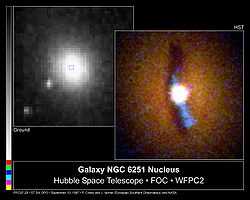NGC 6251
| NGC 6251 | |
|---|---|
 Hubble image of the heart of the active galaxy NGC 6251 | |
| Observation data (J2000 epoch) | |
| Constellation | Ursa Minor |
| Right ascension | 16h 32m 31.9700s[1] |
| Declination | +82° 32′ 16.400″[1] |
| Redshift | 0.02471[1] |
| Distance | 340 million light-years[2] |
| Type | E[1] |
| Apparent dimensions (V) | 1.82´X1.55´ |
| Apparent magnitude (V) | 14.3[3] |
| Other designations | |
| NGC 6251, UGC 10501, LEDA 58472, 6C 1636+8239, QSO B1637+826 | |
| See also: Galaxy, List of galaxies | |
NGC 6251 is an active radio galaxy in the constellation Ursa Minor, and is more than 340 million light-years away from Earth. The galaxy has a Seyfert 2, Active galactic nucleus,[3] and is one of the most extreme examples of a Seyfert galaxy. This galaxy may be associated with gamma-ray source 3EG J1621+8203, which has high-energy gamma-ray emission.[3] It is also noted for its Radio lobe.
Size
This galaxy has an apparent diameter of approximately 9.8 million light-years,[4] which makes it currently (as of 2013) the largest known galaxy in volume. For comparion, the Milky Way is a mere 100 thousand light-years, and the distance between the Milky way and Andromeda is only 2.5 million light-years. Being more than 90 times the size of the Milky Way and 5000 times as massive, if it was where our galaxy is, it would swallow up the whole Local Group, including the Andromeda subgroup as far as the galaxies NGC 3109, Sextans A, and Sextans B.
References
External links
- www.jb.man.ac.uk/atlas/
- Wikisky image of NGC 6251
- Hubble Finds a Bare Black Hole Pouring Out Light (Probing the heart of the active galaxy NGC 6251 -- September 10, 1997)